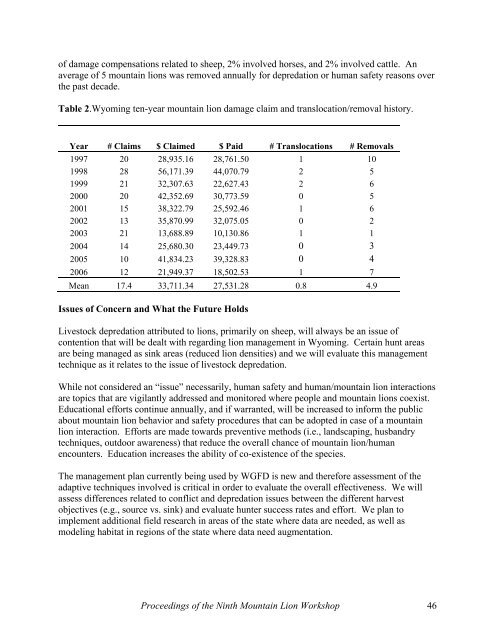Proceedings of the Ninth Mountain Lion Workshop - Carnivore ...
Proceedings of the Ninth Mountain Lion Workshop - Carnivore ...
Proceedings of the Ninth Mountain Lion Workshop - Carnivore ...
You also want an ePaper? Increase the reach of your titles
YUMPU automatically turns print PDFs into web optimized ePapers that Google loves.
<strong>of</strong> damage compensations related to sheep, 2% involved horses, and 2% involved cattle. An<br />
average <strong>of</strong> 5 mountain lions was removed annually for depredation or human safety reasons over<br />
<strong>the</strong> past decade.<br />
Table 2.Wyoming ten-year mountain lion damage claim and translocation/removal history.<br />
Year # Claims $ Claimed $ Paid # Translocations # Removals<br />
1997 20 28,935.16 28,761.50 1 10<br />
1998 28 56,171.39 44,070.79 2 5<br />
1999 21 32,307.63 22,627.43 2 6<br />
2000 20 42,352.69 30,773.59 0 5<br />
2001 15 38,322.79 25,592.46 1 6<br />
2002 13 35,870.99 32,075.05 0 2<br />
2003 21 13,688.89 10,130.86 1 1<br />
2004 14 25,680.30 23,449.73 0 3<br />
2005 10 41,834.23 39,328.83 0 4<br />
2006 12 21,949.37 18,502.53 1 7<br />
Mean 17.4 33,711.34 27,531.28 0.8 4.9<br />
Issues <strong>of</strong> Concern and What <strong>the</strong> Future Holds<br />
Livestock depredation attributed to lions, primarily on sheep, will always be an issue <strong>of</strong><br />
contention that will be dealt with regarding lion management in Wyoming. Certain hunt areas<br />
are being managed as sink areas (reduced lion densities) and we will evaluate this management<br />
technique as it relates to <strong>the</strong> issue <strong>of</strong> livestock depredation.<br />
While not considered an “issue” necessarily, human safety and human/mountain lion interactions<br />
are topics that are vigilantly addressed and monitored where people and mountain lions coexist.<br />
Educational efforts continue annually, and if warranted, will be increased to inform <strong>the</strong> public<br />
about mountain lion behavior and safety procedures that can be adopted in case <strong>of</strong> a mountain<br />
lion interaction. Efforts are made towards preventive methods (i.e., landscaping, husbandry<br />
techniques, outdoor awareness) that reduce <strong>the</strong> overall chance <strong>of</strong> mountain lion/human<br />
encounters. Education increases <strong>the</strong> ability <strong>of</strong> co-existence <strong>of</strong> <strong>the</strong> species.<br />
The management plan currently being used by WGFD is new and <strong>the</strong>refore assessment <strong>of</strong> <strong>the</strong><br />
adaptive techniques involved is critical in order to evaluate <strong>the</strong> overall effectiveness. We will<br />
assess differences related to conflict and depredation issues between <strong>the</strong> different harvest<br />
objectives (e.g., source vs. sink) and evaluate hunter success rates and effort. We plan to<br />
implement additional field research in areas <strong>of</strong> <strong>the</strong> state where data are needed, as well as<br />
modeling habitat in regions <strong>of</strong> <strong>the</strong> state where data need augmentation.<br />
<strong>Proceedings</strong> <strong>of</strong> <strong>the</strong> <strong>Ninth</strong> <strong>Mountain</strong> <strong>Lion</strong> <strong>Workshop</strong> 46
















